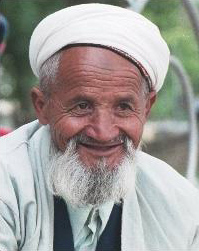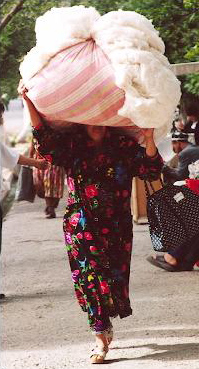Turkmenistan & Uzbekistan
Day 12 -
Wednesday, 3 May 2000
Villages enroute to Samarkand

Before departure from Shakrisabz, we walked through the village, taking pictures, greeting the people, and shopping.
Jim and I also visited the neglected monuments in this town where Emir Timur (Tamerlane) was born in the 14th century. He had built a mausoleum for himself here because it was where he wanted to be buried. But his body is not here.
Samarkand
After a long bus ride, we arrived in Samarkand in time to visit the Mausoleum of Timur, where his body resides. He had died as he began a military campaign to China in the summer. He was entombed in Samarkand, because Shakrisabz was too far to carry a corpse in the desert heat.
Here his body rests beneath an astonishing monument. The late afternoon rays of the sun were slanted across the monument and the rose garden inside the low walls surrounding it. Inside, workers are busy restoring, bringing it back hopefully to the glory it had in the beginning. Our Tajik guide, Aziza, is very knowledgeable and helpful, but her voice is very soft, and it was often hard to hear what she was saying.

In response to questions, she told us that Timur has been given as a hero to the people to avoid a vacuum. It was not an uprising of the people's choosing from old memories. Three generations is long enough to wipe out that kind of memory, and only the study of history can keep it alive. "The people like it when someone manages them," our guide told us.
Timur is very important to the Central Asian people of today as the symbol of their history and a standard for their identity. Although Timur was a vicious conqueror, he also collected intelligentsia (including architects, builders, and craftsmen) from all the cites he conquered, and used them to build a new culture. It is that culture, which really was reigned over by his grandson Ulugh Beg, that is the shining focus for the people.
A Russian archeologist had excavated this mausoleum, and found the graves, with an inscription at the entrance. He learned that the inscription was a warning, to "whoever opens this grave," that such a person would "invite the spirit of war" much worse than the wars of conquest by Timur. He returned to the site to discover that the graves had already been opened by his workers. The next day, or a few days later, Hitler invaded Russia.
After dinner, we went to a sound and light show at the Registan Square. Meli and Jim were both quite upset to see that a wooden structure has been built for people watching the show, instead of just sitting on the grass as had been done before. The structure completely alters the site, turning what was a visit to ancient monuments into a semi-Disneyland experience. The sound and light show turn out to be just as disappointing, and Meli apologized to us.
This kind of thing is quite disturbing to Meli. It is her pleasure to visit these sites before they are spoiled, and it is her sorrow to see them when they have been spoiled. Jim, who put together her CD slide show, was especially disappointed. He had looked forward to taking a photo such as Meli had on the slide show. The wooden structure blocks that view and never again can such a photo be taken.
I think this must be part of the experience and of our education. We are running in front of "globalization," Meli says. But we are not running fast enough. It's catching up. Mary had said something earlier in the trip, about feeling that she always arrives at these places at the wrong time. Too late to see them before they began to be altered (destroyed or reconstructed), and too early to see all that the archeologists and historians have uncovered and learned. In any case, we are able to see that changes are happening very fast, and they are not all for the better.